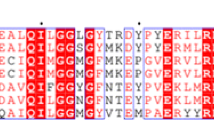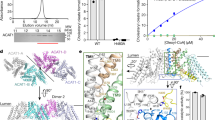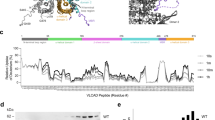Abstract
Acyl-CoA dehydrogenase deficiency (ACAD) is an inherited and potentially fatal disorder with variable clinical symptoms. The relationship between pathogenicity and deleterious point mutations is investigated here in ACAD structures of short (SCAD) and medium-chain (MCAD) types. Structures and dynamic features of native and mutant forms of enzymes models were compared. A total of 2.88 µs molecular dynamics simulations were performed at four different temperatures. Total energy, RMSD, protein ligand interactions and affinity, RMSF measures, secondary structure changes, and important interactions were studied. Mutations in the three main domains of ACADs are pathogenic, while those located at linker turns are not. Mutations affect mostly tetramer formations, secondary structures, and many contacts and interactions. In R206H (MCAD mutant) which is experimentally known to cause a huge turnover decrease, the lack of a single H-bond between substrate and FAD was observed. Secondary structures showed temperature-dependent changes, and SCAD activity was found to be highly correlated to the enzyme helix 3–10 content. Finally, RMSF patterns pointed to one important loop that maintains the substrate close to the active site and is a cause of substrate wobbling upon mutation. Despite similar structure, function, and cellular location, SCAD and MCAD may have different optimum temperatures that are related to the structure taken at that specific temperature. In conclusion, new insight has been provided on the effect of various SCAD and MCAD pathogenic mutations on the structure and dynamical features of the enzymes.


















Similar content being viewed by others
Data availability
Data is reported in the manuscript and in the supplementary file info; in case details of those data are needed, they are available upon reasonable request from the authors.
References
Soler-Alfonso, C., M.J. Bennett, M.J., Ficicioglu, C.: Screening for medium-chain acyl CoA dehydrogenase deficiency: current perspectives. Res. Rep. Neonatol. (2016). https://doi.org/10.2147/RRN.S60617
Ghosh, S., Kruger, C., Wicks, S., Simon, J., Kumar, KJ., Johnson W.D., Mynatt R.L., Noland R.C., Richards B.K.: Short chain acyl-CoA dehydrogenase deficiency and short-term high-fat diet perturb mitochondrial energy metabolism and transcriptional control of lipid-handling in liver. Nutr. Metab. (2016). https://doi.org/10.1186/s12986-016-0075-0
Battaile, K.P., Nguyen, T.V., Vockley J., Kim, J-J.P.: Structures of isobutyryl-coa dehydrogenase and enzyme-product complex comparison with isovaleryl-and short-chain acyl-coa dehydrogenases. J. Biol. Chem. (2004). https://doi.org/10.1074/jbc.M400034200
Bross, P., Jespersen, C., Jensen T.G., Andresen, B.S., Kristensen M.J., Winter, V., Nandy, A., Kräutle, F.,Ghisla S., Bolundi, L.: Effects of two mutations detected in medium chain acyl-CoA dehydrogenase (MCAD)-deficient patients on folding, oligomer assembly, and stability of MCAD enzyme. J. Biol. Chem. (1995). https://doi.org/10.1074/jbc.270.17.10284
Placzek, S., Schomburg,I., Chang, A., Jeske, L., Ulbrich, M., Tillack, J., Schomburg, D.: BRENDA in 2017: new perspectives and new tools in BRENDA. Nucleic Acids Res. (2016). https://doi.org/10.1093/nar/gkw952
Jethva, R., Bennett, M.J., Vockley, J.: Short-chain acyl-coenzyme A dehydrogenase deficiency. Mol. Genet. Metab. (2008). https://doi.org/10.1016/j.ymgme.2008.09.007
Van Hove, J., Zhang, W., Kahler, S.G., Roe, C.R., Chen, Y.T., Terada, N., Chace, D.H., Iafolla, A.K., Ding, J.H., Millington, D.S.: Medium-chain acyl-CoA dehydrogenase (MCAD) deficiency: diagnosis by acylcarnitine analysis in blood. Am. J. Hum. Genet. 52, 958–966 (1993)
Nguyen, T.V., Riggs, C., Babovic-Vuksanovic, D., Kim, Y-S., Carpenter J.F., Burghardt, T.P., Gregersen, N., Vockley, J.: Purification and characterization of two polymorphic variants of short chain acyl-CoA dehydrogenase reveal reduction of catalytic activity and stability of the Gly185Ser enzyme. Biochemistry (2002). https://doi.org/10.1021/bi026030r
Thorpe, C., Kim, J.: Structure and mechanism of action of the acyl-CoA dehydrogenases. FASEB J. (1995). https://doi.org/10.1096/fasebj.9.9.7601336
Schopfer, L.M., Massey, V., Claiborne, A.: Active site probes of flavoproteins. Determination of the solvent accessibility of the flavin position 8 for a series of flavoproteins. J. Biol. Chem. 256, 7329–7337 (1981). https://doi.org/10.1016/S0021-9258(19)68966-0
Ghisla, S., Engst,S., Vock,P., Kieweg, V., Bross,P., Nandy, A., Rasched, I., Strauss, A.W.: Mechanism of alpha, beta-dehydrogenation by acyl-CoA dehydrogenases. In: Flavins and Flavoproteins, Proceedings of the 11th Symposium, pp. 283–292. Nagoya (1994)
Pedersen, C.B., Kølvraa, S., Kølvraa, A., Stenbroen, V., Kjeldsen, M., Ensenauer, R., Tein, I., Matern, D., Rinaldo, P., Vianey-Saban, C., Ribes, A., Lehnert, W., Christensen, E., Corydon, T.J., Andresen, B.S., Vang, S., Bolund, L., Vockley, J., Bross, P., Gregersen, N.: The ACADS gene variation spectrum in 114 patients with short-chain acyl-CoA dehydrogenase (SCAD) deficiency is dominated by missense variations leading to protein misfolding at the cellular level. Hum. Genet. (2008). https://doi.org/10.1007/s00439-008-0521-9
Andresen, B.S., Olpin, S., Poorthuis, B.J., Scholte, H.R., Vianey-Saban, C., Wanders, R., Ijlst, L., Morris, A., Pourfarzam, M., Bartlett, K., Baumgartner, E.R., deKlerk, J.B., Schroeder, L.D., Corydon, T.J., Lund, H., Winter, V., Bross, P., Bolund, L., Gregersen, N.: Clear correlation of genotype with disease phenotype in very–long-chain acyl-CoA dehydrogenase deficiency. Am. J. Hum. Genet. (1999). https://doi.org/10.1086/302261
Ijlst, L., Ruiter, J.P., Hoovers, J.M., Jakobs, M.E., Wanders, R.J.: Common missense mutation G1528C in long-chain 3-hydroxyacyl-CoA dehydrogenase deficiency. Characterization and expression of the mutant protein, mutation analysis on genomic DNA and chromosomal localization of the mitochondrial trifunctional protein alpha subunit gene. J. Clin. Invest. (1996). https://doi.org/10.1172/JCI118863
Andresen, B.S., Dobrowolski S.F., O'Reilly, L., Muenzer J., McCandless, S.E., Frazier, D.M., Udvari, S., Bross, P., Knudsen, I., Banas, R., Chace, D.H., Engel, P., Naylor, E.W., Gregersen, N.: Medium-chain acyl-CoA dehydrogenase (MCAD) mutations identified by MS/MS-based prospective screening of newborns differ from those observed in patients with clinical symptoms: identification and characterization of a new, prevalent mutation that results in mild MCAD deficiency. Am. J. Hum. Genet. (2001). https://doi.org/10.1086/320602
Dessein, A.-F., Fontaine, M., Joncquel-Chevalier, Curt, M., Briand, G., Sechter, C., Mention-Mulliez, K., Dobbelaere, D., Douillard, C., Lacour, A., Redonnet-Vernhet, I., Lamireau, D., Barth M., Minot-Myhié, M.-C., Kuster, A., de Lonlay, P., Gregersen, N., Acquaviva, C., Vianey-Saban, C., Vamecq, J.: Fluxomic evidence for impaired contribution of short-chain acyl-CoA dehydrogenase to mitochondrial palmitate β-oxidation in symptomatic patients with ACADS gene susceptibility variants. Clin. Chim. Acta (2017). https://doi.org/10.1016/j.cca.2017.05.026
Piercy, H., Nutting, C., Yap, S.: “It’s just always eating”: the experiences of young people growing up medium chain acyl-CoA dehydrogenase deficiency. Glob. Qual. Nurs. Res. (2021). https://doi.org/10.1177/23333936211032203
Purevsuren, J., Hasegawa, Y., Fukuda S., Kobayashi, H., Mushimoto, Y., Yamada, K., Takahashi, T., Fukao, T., Yamaguchi, S.: Clinical and molecular aspects of Japanese children with medium chain acyl-CoA dehydrogenase deficiency. Mol. Genet. Metab. (2012). https://doi.org/10.1016/j.ymgme.2012.06.010
Jank, J.M., Maier, E.M., Reiß, D.D., Haslbeck, M., Kemter, K.F., Truger, M.S., Sommerhoff, C.P., Ferdinandusse, S., Wanders, R.J., Gersting, S.W., Muntau, A.C.: The domain-specific and temperature-dependent protein misfolding phenotype of variant medium-chain acyl-CoA dehydrogenase. PLoS One (2014). https://doi.org/10.1371/journal.pone.0093852
Schatz, U.A., Ensenauer, R.: The clinical manifestation of MCAD deficiency: challenges towards adulthood in the screened population. J. Inherit. Metab. Dis. (2010). https://doi.org/10.1007/s10545-010-9115-5
Maier E.M., Gersting S.W., Kemter K.F., Jank J.M., Reindl M., Messing D.D., Truger M.S., Sommerhoff C.P., Muntau A.C.: Protein misfolding is the molecular mechanism underlying MCADD identified in newborn screening. Hum. Mol. Genet. https://doi.org/10.1093/hmg/ddp079
Bross, P., Jespersen, C., Jensen, T.G., Andresen, B.S., Kristensen, M.J., Winter, V., Nandy, A., Kräutle, F., Ghisla, S., Bolund, L., Kim, J.-J.P., Gregersen, N.: Effects of two mutations detected in medium chain Acyl-CoA dehydrogenase (MCAD)-deficient patients on folding, oligomer assembly, and stability of MCAD enzyme. J. Biol. Chem. (1995). https://doi.org/10.1074/jbc.270.17.10284
Pedersen, C.B., Bross, P., Winter, V.S., Corydon, T.J., Bolund, L., Bartlett, K., Vockley, J., Gregersen, N.: Misfolding, degradation and aggregation of variant proteins–the molecular pathogenesis of short chain acyl-CoA dehydrogenase (SCAD) deficiency. J. Biol. Chem. (2003). https://doi.org/10.1074/jbc.M309514200
Bross P., Andresen B.S., Winter V., Kräutle F., Jensen T.G., Nandy A., Kølvraa S., Ghisla S., Bolund L., Gregersen N.: Co-overexpression of bacterial GroESL chaperonins partly overcomes non-productive folding and tetramer assembly of E. coli-expressed human medium-chain acyl-CoA dehydrogenase (MCAD) carrying the prevalent disease-causing K304E mutation. Biochim. Biophys. Acta (1993). https://doi.org/10.1016/0925-4439(93)90068-c
Shinwari, K., Rehman, H.M., Xiao, N., Guojun, L., Khan, M.A., Bolkov, M.A., Tuzankina, I.A., Chereshnev, V.A.: Novel high-risk missense mutations identification in FAT4 gene causing Hennekam syndrome and Van Maldergem syndrome 2 through molecular dynamics simulation. Inform. Med. Unlocked (2023). https://doi.org/10.1016/j.imu.2023.101160
Witham, S., Takano, K., Schwartz, C., Alexov, E.: A missense mutation in CLIC2 associated with intellectual disability is predicted by in silico modeling to affect protein stability and dynamics.Proteins. (2011). https://doi.org/10.1002/prot.23065
Kumar, A., Rajendran, V., Sethumadhavan, R., Purohit R.: In silico prediction of a disease-associated STIL mutant and its affect on the recruitment of centromere protein J (CENPJ). FEBS Open Bio. (2012). https://doi.org/10.1016/j.fob.2012.09.003
Bhardwaj, V., Purohit, R.: Computational investigation on effect of mutations in PCNA resulting in structural perturbations and inhibition of mismatch repair pathway. J. Biomol. Struct. Dyn. (2019). https://doi.org/10.1080/07391102.2019.1621210
Tonin, R., Caciotti, A., Funghini, S., Pasquini, E., Mooney, S.D., Cai, B., Proncopio, E., Donati, M.A., Baronio, F., Bettocchi, I., Cassio, A., Biasucci, G., Bordugo, A., la Marca, G., Guerrini, R., Morrone, A.: Clinical relevance of short-chain acyl-CoA dehydrogenase (SCAD) deficiency: exploring the role of new variants including the first SCAD-disease-causing allele carrying a synonymous mutation. BBA Clin. (2016). https://doi.org/10.1016/j.bbacli.2016.03.004
Muckstein, U., Hofacker, I.L., Stadler P.F.: Stochastic pairwise alignments. Bioinformatics (2002). https://doi.org/10.1093/bioinformatics/18.suppl_2.s153
Krieger, E., Vriend, G.: YASARA view - molecular graphics for all devices - from smartphones to workstations. Bioinformatics (2014). https://doi.org/10.1093/bioinformatics/btu426
Chen V.B., Arendall, W.B. 3rd, Headd, J.J., Keedy, D.A., Immormino, R.M., Kapral, G.J., Murray L.W., Richardson, J.S., Richardson, D.C.: MolProbity: all-atom structure validation for macromolecular crystallography. Acta Crystallogr. D Biol. Crystallogr. (2010). https://doi.org/10.1107/S0907444909042073
Laskowski, R.A., MacArthur, M.W., Moss, D.S., Thornton, J.M.: PROCHECK: a program to check the stereochemical quality of protein structures. J. Appl. Cryst. (1993). https://doi.org/10.1107/S0021889892009944
Wang, S.S., Fernhoff, P.M., Hannon, W.H., Khoury, M.J.: Medium chain acyl-CoA dehydrogenase deficiency: human genome epidemiology review. Genet. Med. (1999). https://doi.org/10.1097/00125817-199911000-00004
Li M., Simonetti, F.L., Goncearenco, A., Panchenko, A.R.: MutaBind estimates and interprets the effects of sequence variants on protein–protein interactions. Nucleic Acids Res. (2016). https://doi.org/10.1093/nar/gkw374
Krieger, E., Vriend, G.: New ways to boost molecular dynamics simulations. J. Comput. Chem. (2015). https://doi.org/10.1002/jcc.23899
Krieger, E., Dunbrack, R.L., Jr., Hooft, R.W.W., Krieger, B.: Assignment of protonation states in proteins and ligands: combining pK a prediction with hydrogen bonding network optimization. Methods Mol. Biol. (2012). https://doi.org/10.1007/978-1-61779-465-0_25
Maier, J.A., Martinez, C., Kasavajhala, K., Wickstrom, L., Hauser, K.E., Simmerling, C.: ff14SB: improving the accuracy of protein side chain and backbone parameters from ff99SB. J. Chem. Theory Comput. (2015). https://doi.org/10.1021/acs.jctc.5b00255
Wang, J., Wolf, R.M., Caldwell, J.W., Kollman, P.A.: Case, DA,: Development and testing of a general amber force field. J. Comput. Chem. (2004). https://doi.org/10.1002/jcc.20035
Jakalian, A., Jack, D.B., Bayly, C.I.: Fast, efficient generation of high‐quality atomic charges. AM1‐BCC model: II. Parameterization and validation. J. Comput. Chem. (2002). https://doi.org/10.1002/jcc.10128
Hornak, V., Abel, R., Okur, A., Strockbine, B., Roitberg, A., Simmerling, C.: Comparison of multiple Amber force fields and development of improved protein backbone parameters. Proteins (2006). https://doi.org/10.1002/prot.21123
Essmann, U., Perera, L., Berkowitz, M.L., Darden, T., Lee, H., Pedersen, L.G.: A smooth particle mesh Ewald method. J. Chem. Phys. (1995). https://doi.org/10.1063/1.470117
Darden, T., York, D., Pedersen, L.: Particle mesh Ewald: an N⋅ log (N) method for Ewald sums in large systems. J. Chem. Phys. (1993). https://doi.org/10.1063/1.464397
Darden, T., York, D., Pedersen, L.: The effect of long-range electrostatic interactions in simulations of macromolecular crystals–a comparison of the ewald and truncated list methods. J. Chem. Phys. (1993). https://doi.org/10.1063/1.465608
Genheden, S., Ryde, U.: The MM/PBSA and MM/GBSA methods to estimate ligand-binding affinities. Expert Opin. Drug Discov. (2015). https://doi.org/10.1517/17460441.2015.1032936
Kim, J., Wu, J.: Structure of the medium-chain acyl-CoA dehydrogenase from pig liver mitochondria at 3-A resolution. Proc. Natl. Acad. Sci. USA (1988). https://doi.org/10.1073/pnas.85.18.6677
Howe K. L., Achuthan P., Allen J., Allen J., Alvarez-Jarreta J., Amode M.R., et al.: Ensembl 2021. Nucleic Acids Res. (2021). https://doi.org/10.1093/nar/gkaa942
Banerjee, A., Saha, S., Tvedt, N.C., Yang, L.-W., Bahar, I.: Mutually beneficial confluence of structure-based modeling of protein dynamics and machine learning methods. Curr. Opin. Struct. Biol. (2023). https://doi.org/10.1016/j.sbi.2022.102517
Shirao, K., Okada, S., Tajima, G., Tsumura, M., Hara, K., Yasunaga, S., Ohtsubo, M., Hata, I., Sakura, N., Shigematsu, Y., Takihara, Y., Kobayashi, M.: Molecular pathogenesis of a novel mutation, G108D, in short-chain acyl-CoA dehydrogenase identified in subjects with short-chain acyl-CoA dehydrogenase deficiency. Hum Genet. (2010). https://doi.org/10.1007/s00439-010-0822-7
Gregersen, N., Winter, V.S., Corydon, M.J., Corydon, T.J., Rinaldo, P., Ribes, A., Martinez, G., Bennett, M.J., Vianey-Saban, C., Bhala, A., Hale, D.E., Lehnert, W., Kmoch, S., Roig, M., Riudor, E., Eiberg, H., Andresen, B.S., Bross P., Bolund, L.A., Kølvraa, S.: Identification of four new mutations in the short-chain acyl-CoA dehydrogenase (SCAD) gene in two patients: one of the variant alleles, 511C→ T, is present at an unexpectedly high frequency in the general population, as was the case for 625G→ A, together conferring susceptibility to ethylmalonic aciduria. Hum. Mol. Genet. (1998). https://doi.org/10.1093/hmg/7.4.619
Naito, E., Ozasa, H., Ikeda, Y., Tanaka K.: Molecular cloning and nucleotide sequence of complementary DNAs encoding human short chain acyl-coenzyme A dehydrogenase and the study of the molecular basis of human short chain acyl-coenzyme A dehydrogenase deficiency. J. Clin. Invest. (1989). https://doi.org/10.1172/JCI114058
Chrétien, D., Bénit, P., Ha, H.-H., Keipert, S., El-Khoury, R., Chang, Y.-T., Jastroch, M., Jacobs, H.T., Rustin, P., Rak, M.: Mitochondria are physiologically maintained at close to 50 degrees C. PLoS Biol. (2018). https://doi.org/10.1371/journal.pbio.2003992
Lane, N.: Hot mitochondria? PLoS Biol. (2018). https://doi.org/10.1371/journal.pbio.2005113
Tajima, G., Hara, K., Tsumura, M., Kagawa, R., Okada, S., Sakura, N., Hata, I., Shigematsu, Y., Kobayashi, M.: Screening of MCAD deficiency in Japan: 16 years’ experience of enzymatic and genetic evaluation. Mol. Genet. Metab. (2016). https://doi.org/10.1016/j.ymgme.2016.10.007
Gao D., Chundawat, S.P.S., Sethi A., Balan V., Gnanakaran S., Dale B.E.: Increased enzyme binding to substrate is not necessary for more efficient cellulose hydrolysis. Proc. Natl. Acad. Sci. USA (2013). https://doi.org/10.1073/pnas.1213426110
O'Reilly, L., Bross, P., Corydon, T.J., Olpin, S.E., Hansen, J., Kenney, J.M., McCandless, S.E., Frazier, D.M., Winter, V., Gregersen, N., Enge,l P.C., Andresen, B.S.: The Y42H mutation in medium‐chain acyl‐CoA dehydrogenase, which is prevalent in babies identified by MS/MS‐based newborn screening, is temperature sensitive. Eur. J. Biochem. (2004). https://doi.org/10.1111/j.1432-1033.2004.04343.x
Amendt, B.A., Freneaux, E., Reece, C., Wood, P.A., Rhead, W.J.: Short-chain acyl-coenzyme A dehydrogenase activity, antigen, and biosynthesis are absent in the BALB/cByJ mouse. Pediatr. Res. (1992). https://doi.org/10.1203/00006450-199206000-00003
Curtis, D., Blakemore, A.I., Engel, P.C., Macgregor, D., Besley, G., Kolvraa, S., Gregersen, N.: Heterogeneity for mutations in medium chain acyl‐CoA dehydrogenase deficiency in the UK population. Clin. Genet. (1991). https://doi.org/10.1111/j.1399-0004.1991.tb03097.x
Funding
This study has been supported by the Endocrinology and Metabolism Research Institute (EMRI) of Tehran University of Medical Sciences.
Author information
Authors and Affiliations
Contributions
The project was designed by AEH and discussed upon with HF to refine and reach the final details. Experiments have been carried out by HF and discussed all along by both authors. HF has written the first draft, which was edited by AEH and finalized by both authors.
Corresponding author
Ethics declarations
Ethical approval
The project was evaluated and approved by the internal ethical committee of EMRI.
Consent to participate
NA.
Competing interests
The authors declare no competing interests.
Additional information
Publisher's Note
Springer Nature remains neutral with regard to jurisdictional claims in published maps and institutional affiliations.
Supplementary Information
Below is the link to the electronic supplementary material.
Rights and permissions
Springer Nature or its licensor (e.g. a society or other partner) holds exclusive rights to this article under a publishing agreement with the author(s) or other rightsholder(s); author self-archiving of the accepted manuscript version of this article is solely governed by the terms of such publishing agreement and applicable law.
About this article
Cite this article
Faraji, H., Ebrahim-Habibi, A. Structural insights into the pathogenicity of point mutations in human acyl-CoA dehydrogenase homotetramers. J Biol Phys 50, 89–118 (2024). https://doi.org/10.1007/s10867-023-09650-2
Received:
Accepted:
Published:
Issue Date:
DOI: https://doi.org/10.1007/s10867-023-09650-2




